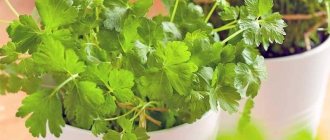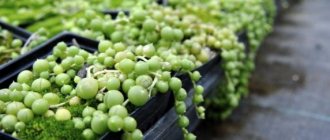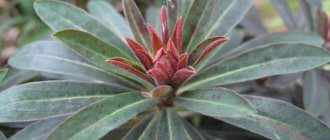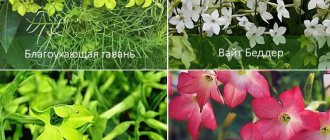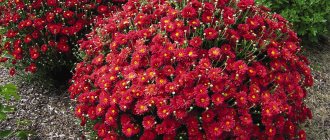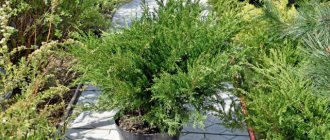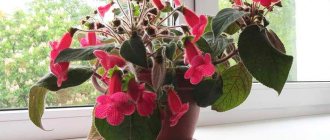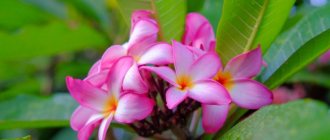Woolly chist, sheep's ear or woolly stachys (lat. Stachys byzantina) is a perennial herbaceous plant 20-60 cm high from the Lamiaceae family. Oblong leaves with felt pubescence, which you just want to stroke, sit opposite on erect stems. Thanks to its interesting appearance, the popular name for stahis is sheep's ears. The dark green shade of the leaves emphasizes the white-silver pubescence. The stems are erect and branched.
Stachys woolly blooms from May to August. Whorls of pretty pink flowers form a spike-shaped inflorescence. Flower growers are very attracted to the leaves and in most cases the inflorescences are picked before they bloom. Already in the first year a lawn will form, and in the next season you will get an almost continuous mat.
In the wild, the Byzantine chist is found in Iran, Armenia, Turkey, the Caucasus, and the Black Sea region.
Sheep ears are propagated by seeds and vegetatively (dividing the bush, cuttings).
Chistets sheep ears growing from seeds
Chistets stakhis sheep ears seeds photo
In warm regions, they are sown immediately in open ground in spring or before winter. Simply dig up the area, scatter the seeds and cover with a rake. If winters are harsh in your area, it is better to take care of growing seedlings.
The seeds germinate quickly (from 5 to 10 days) and without problems, and the seedlings are tolerant of transplantation; they can even “roam” around the site several times a season.
- Pour the sand-peat mixture into a wide container, spread the seeds on top, sprinkle with the thinnest layer of sand and spray with a fine sprayer.
- You can germinate without shelter, just try to spray the soil daily, diffused lighting is required, and maintain the temperature within 20-25 °C.
Chistets woolly stachys sheep ears from seeds photo shoots
- If necessary, thin out dense seedlings; before transplanting into open ground, seedlings can be grown in the same container.
- Dig holes according to the size of the root system, transfer the seedlings along with the earthen ball, and when planting, maintain a gap of about 15 cm.
Planting and caring for Chistets Woolly
Since the seed material germinates well, growing the crop yourself is quite simple. Seeds of Chistets Woolly can be sown at the end of the winter period or immediately with the arrival of spring in pots. After sowing, the area should be watered, covered with film, and hidden in a warm room.
You can observe seedlings after 1 month, and after the formation of the first pair of leaves, you can dive.
Landing in the ground
At the end of May, when the threat of frost has passed, you can proceed to planting seed material in open soil. The optimal place for the plant is considered to be a sunny or semi-shaded place. It doesn't matter what the soil is like. Both sandy and rocky soils are suitable; the reaction can be alkaline or neutral. The only important condition is a high level of soil moisture.
The landing holes are located at a distance of 15-20 centimeters from each other. Drainage material is placed at the bottom. Pebbles, stones and coarse sand are suitable for such purposes. Soil with humus is laid on top. The seedlings, together with a ball of earth, are placed in holes, and when the planting is completed, thorough watering will be required.
Watering rules
The Chistets Woolly flower requires systematic watering, as well as removing weeds and loosening the soil. Irrigation is carried out in moderation; it is important that there is no stagnation of water. It is recommended to water only after long dry periods. Otherwise, the crop quickly sheds its leaves.
Plant nutrition
Rotted compost is used as fertilizer; it is recommended to apply it to the soil once a season.
Pruning Stachys Lanata
When growing Chistets Woolly, it is extremely important to regulate the territory of its distribution. You will definitely need to trim shoots that extend beyond the site.
It is also extremely important to trim the flower stems while the seeds are forming. They will not only spoil the appearance, but will also cause a lot of hassle with self-seeding. Keep in mind that over time, a void forms in the middle of the rosette; you will need to replant young bushes once every 3-4 years.
What diseases are plants susceptible to?
Sheep ears are rarely affected by diseases and pests. Only when the amount of moisture added is exceeded can fungal diseases form. This can cause rotting. Plants that are severely damaged are removed from the site, and the soil must be treated with fungicidal preparations.
Wintering culture
The perennial representative can withstand the cold season without any problems. Shelter may only be required in very snowless winters. To protect the plant, spruce branches are used. Gardeners also often ask whether it is necessary to prune Chistets Woolly for the winter. This procedure is required.
Vegetative propagation of Stachys
Dividing the bush
How to divide a bush of Stachys woolly
After 2-3 years of growth, the Byzantine chistets can already be divided. In the spring, carefully dig up the bush along with a lump of earth, preferably manually divide it into several parts and plant it in separate holes at a distance of 15-20 cm from each other.
Propagation by cuttings
Cuttings (shoots with 2-4 leaves or individual leaves from the bottom of the stem) can be cut throughout the season; they take root in 2-3 weeks. Plant in a moist mixture of sand and peat, but water sparingly to prevent them from rotting. When signs of growth appear, they can be planted separately.
Growing conditions
The plant loves light and grows well in open and sunny areas, but it can also be grown in partial shade. The culture is winter-hardy, prefers light-drained soil with a certain composition of rotted manure or plant fertilizer. The woolly chickweed grows very well in dry areas. In damp soil it quickly rots, and the luxurious pubescence of its leaves is lost. Tubers left in the soil for the winter season do not die. The growing season of the flower is 130-140 days.
Landing area
Sheep ears in the garden photo
It should be noted that when grown in too fertile soil, the leaves of stachys may become simply green, and the decorative pubescence will be lost. The best option would be loose soil of average fertility.
Areas under bright light, as well as in the diffuse shade of shrubs and trees, are suitable for planting. In cool lighting, the texture of the leaves stands out very effectively.
It cannot be grown in lowlands and flooded areas, since dampness is the main “enemy” of stachys.
Features of Chistets
The aerial parts of Stachys are covered with dense pubescence, even its leaf blades. In this regard, this plant is also called “sheep’s ear.” The height of the bush can reach up to 100 centimeters. Opposite leaf plates can be solid or jagged. The flowers are part of false whorls, which in turn form spike-shaped inflorescences. The color of the flowers can be purple, yellow, lilac, pink or white. The fruit is a triangular nut of ovoid or oblong shape.
Woolly Chistets in landscape design photo selection
Sheep ears in landscape design photo
Bluish in color, sheep's ears look impressive against the backdrop of bright green conifers, a beautiful combination with heather.
Chistets Byzantine at the dacha photo flower bed
Chistets Byzantine grows excellently and pleases with the beauty of its soft leaves on retaining walls, alpine hills, in rocky gardens, and rockeries.
Stachys woolly and sedum in a flower bed photo
Elegant, low bushes are excellent in border plantings. Used as a frame for a path or garden bed, creating a fabulous atmosphere thanks to the silver shade.
Woolly Chistets in garden design photo
As mentioned earlier, partial shade emphasizes the charm of stachys, so it is often planted near shrubs and trees.
Stachys woolly in the garden photo
For neighbors, choose decorative foliage plants of green or variegated colors. For example, echinacea, cypress spurge, hosta, heuchera, sedum.
Stachys woolly in landscape design photo
Thanks to its neutral shade, Stachys woolly goes well and opens up in a new way in a duet with brightly flowering plants.
Woolly Chistets with other flowers in a flower bed photo
The combination with blue and snow-white flowers is especially advantageous, but nearby pink, yellow, and lilac look no worse.
Woolly Chistets in a flowerbed photo
Combine with mantle, marigold, chives, lavender, ragwort, and chives.
Hemanthus in nature
The hare's ear flower is a heat-loving plant. In the wild, it grows in tropical Africa in the Cape Province. Here on the mountain slopes in the shade of spreading bushes this plant feels simply excellent. The name “hemanthus” was coined for it by Carl Linnaeus in 1753. It is translated as “bloody.” Indeed, plants with bright red flowers are mostly common in nature. However, over the centuries, other varieties have been developed that have flowers of a different shade. These include Hemanthus white-flowered. It is also quite a showy plant. Its inflorescence is large in size and looks fluffy due to the large number of stamens. Hence another name for hemanthus – “hare’s tail”.
Varieties of Stachys woolly with photos and names
Chistets Byzantine variety Helen Von Stein photo
The Helen Von Stein variety is distinguished by large fluffy leaves with a velvety surface; during the flowering season it does not lose its decorative effect: bluish woolly shoots with flowers stand out effectively against the background of their brighter neighbors.
Stachys byzantina 'Big Ears' photo
Big Ears is a low plant with hairy leaves up to 25 cm long.
Sheila Macqueen and Silver Carpet are compact bushes about 15 cm high. Both varieties do not bloom; when planted densely, they create a ground cover effect.
Woolly Chick Stachys byzantina Cotton Ball photo
Cotton Ball – perhaps you shouldn’t pick off the flowers, since the inflorescences look like cotton bolls.
Chistets Byzantine Stachys byzantina 'Striped Phantom' photo with other flowers
Striped Phantom - leaves with white longitudinal stripes, flowers of a bright yellow hue.
Common varieties and popular varieties
- Silver Carpet and Sheila Macqueen. The main difference between these varieties is the almost complete absence of peduncles. The leaves are arranged very closely to each other and cover the soil with a dense, silvery carpet. Ideal for decorating borders along garden paths.
Silver Carpet
- Cotton Boll - instead of small flowers, the stem is crowned with a spikelet of round cotton bolls.
Cotton Ball
- Big Ears, the name of this variety, fully justifies itself. The literal translation of the name is “big ears.” The leaves of this stachys have the shape of an elongated oval and reach a length of 250 mm.
Big Ears
- Primrose Heron – golden bizantine. The soft fluffy leaves have a rich yellow-green color.
Primrose Heron
When choosing woolly stachys, it is advisable to look at the photos provided in order to have a more complete understanding of it.
In addition to woolly varieties, many other varieties are found in nature. Some of them are even eaten. Chistets related, which is popularly called Chinese artichoke, has small spiral-shaped nodules on its rhizomes. They have a spicy taste and high nutritional value. In Brazil, varieties are grown that have edible leaves, they are fried in batter, blanched and used in the preparation of national dishes. There are also known medicinal varieties Stachys officinalis and Stachys sieboldii, which are successfully used in traditional medicine recipes.
Useful properties of the plant
Chistets Byzantine and its varieties are grown exclusively as an ornamental foliage plant. Some other types of chistets have medicinal properties. Thus, preparations based on the forest plant are used by official medicine in gynecology, obstetrics, and the postpartum period. Alcohol tincture has a sedative effect, and is more effective than motherwort. Marsh chistets and pharmaceutical chistets have anti-inflammatory, choleretic, and diuretic properties.
Chistets Byzantine photo
Stachys woolly and echinacea photo
Description
This plant is considered a perennial, has massive elongated leaves, tapering downward. They seem to be wrapped in light gray fluff, which makes them especially decorative and beautiful. This is the beauty of the woolly chick. His photo is presented below.
The flowers of the culture are small, lilac-pink and lilac in color, in dense spike-shaped inflorescences placed on oblong peduncles. Chistets bloom in June-September. Due to the fact that the flower stalks are elongated, they often fall to the ground due to rain.
Application in garden design
The unique appearance of stachys allows you to diversify garden compositions. In addition, the plant can decorate flower arrangements. It is used:
- When creating edging for garden paths and flower beds. Fluffy leaves also look great in multi-layered borders.
- As a main and additional element in rock gardens, rock gardens or flower beds.
- As garden decor as an hanging plant. When planted in a pot, the plant can be hung on a terrace or balcony.
- For making live and dry floral compositions. The foliage retains its decorative appearance for a long time.
The plant combines with flowering and deciduous crops. For example, the combination is excellent with marigolds, bellflowers, ageratum, deciduous crops: hostas, milkweeds, coniferous dwarf shrubs .
Secrets of care
The plant is unpretentious, but you need to follow a few simple growing rules. By following simple care requirements, you can have a thick, fluffy carpet in just a few weeks. Primary requirements:
- Lighting. The Chist loves light. Therefore, it should be planted in well-lit areas. Planting in partial shade is also acceptable. For example, under bushes or in close proximity to larger grasses.
- Temperature conditions. Since the plant naturally feels comfortable in temperate latitudes, the optimal temperature for it is about 25 degrees. But even in hot weather, the crop feels favorable provided it is watered in the evening. This is a frost-resistant species. It winters without any problems under the snow, without special shelters. The foliage is not pruned for the winter, but some gardeners prefer to prune the plant from older shoots.
- Soil requirements. In principle, the type of soil is not a fundamental factor. Stachys can exist in any soil composition. However, you should not plant in soil rich in nutrients; moderate fertility is most acceptable. With an excess of nutrients, the plant loses its decorative appearance. The leaves turn bright green, while losing their muted silvery tint.
- Watering. This is a plant that likes moderate watering. It survives drought well. But excess moisture can lead to rotting of the rhizome and the plant as a whole.
- Nutrition. Fertilizing must be done regularly during the flowering period. This will prepare the crop for wintering. Fertilizers are used of organic and mineral nature. Manure (chicken or cow), ammonium nitrate or mineral complexes are suitable.
- Trimming. After the flowering period, the flower stalks should be removed. Some people prune them before flowering, in cases where there is a need to use the crop as a living carpet without flowers. The plant loses its decorative appearance in the flowering phase: the foliage thins, the bush becomes elongated, and “bald spots” appear. Before wintering, the lower leaves, as well as fragments with defects, are removed.
- Diseases. Stachys may suffer from fungal diseases. This happens if the plant grows in conditions of high humidity or after heavy rain. The plant repels insects with its fluff and specific smell, so pests do not threaten the crop.
In general, culture does not require special attention. It may well grow on its own with minor interventions for correction.
Chistets after flowering
Perennial stachys is highly resistant to frost. But if weather forecasters predict a very frosty winter with little snow, then it is best to cover the bushes with spruce branches. It should be remembered that such a plant can die in the spring if its root system remains in melt water for a long time. Therefore, when choosing a place to plant chistets, you must remember this.
